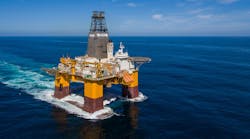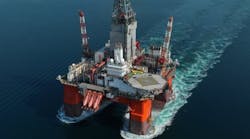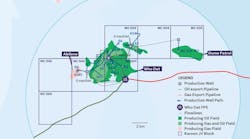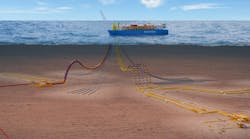New improvements include multi-tool combinability
Dick Ghiselin
Contributing Editor
One sector that seems to be retaining its strength in the face of depressed prices is the measurement-while-drilling and the logging-while-drilling (MWD/LWD) market. The drilling business is somewhat propped up by the requirement to drill on new leases or lose them. However, the requirement to “drill or die” is likely only a temporary respite as many operators prove their undrilled leases, but do not invest in new ones. A notable exception is deepwater offshore, where millions have been invested in very promising prospects. It is hard to see how an operator could turn his back on a prospect that he had already invested multimillions of dollars to secure. Development time for deepwater offshore fields can take a decade or more.
For its part, the service industry knows that it must invest in new technology whose principle objectives are cost-reduction, dry hole reduction, and/or improvement of field recovery factors. And they have achieved some notable successes in delivering on these results.
Defining MWD and LWD
MWD is defined as measurements whose principle objective is improving drilling efficiency.
Considerable progress has been made in this area, with major developments in measurements that extend bit life. Any time an operator can drill a section in a single bit trip is money in the bank. Accordingly, the ability to measure and transmit in real-time downhole weight-on-bit, downhole torque, four-axis vibration, direction and inclination and annular pressure, can enable maximum drilling efficiency. So important is eliminating excessive bit trips that the ability transcends increased penetration rate as the chief money-saver.
Recently, a major improvement in MWD electronics design has extended downhole instrument temperature ratings by as much as 20%. The initial application of this technology was made on rotary-steerable and telemetry systems, upping their ratings to 200°C (392°F). This improvement has significant benefit in extending the range of high-pressure/high-temperature drilling to access deep, hot reservoirs.
As extended-reach drilling (ERD) gains in popularity, the ability to control toolface and MWD strings has taken a prominent position. Drillers of ERD wells must be able to send commands to drilling tools and obtain confirmation that they have been properly received and acted upon. With some ERD wells extending more than 7.5 mi (12 km) from the surface location, the ability to reliably steer becomes the most critical capability to ensure the well is landed precisely in the target formation.
The gap between MWD and LWD tool systems has recently been narrowed with development of a telemetry/geosteering device that allows operators to choose the measurements it needs to manage the cost/price gap between minimum acceptable steering performance and maximum desired savings. By equipping the tool with two gamma ray detectors—one measuring total azimuthal gamma ray and the other measuring natural gamma spectroscopy—a rich data set that can facilitate steering while yielding mineralogy and 360° gamma images has evolved.
The rest of the story
LWD is defined as measurements whose principle objective is finding and evaluating commercial reserves, enabling them to be produced cost-effectively, and/or extending their productive life.
Fundamental among these is geosteering. The ability to use real-time measurements to identify target reservoirs and land the borehole precisely in them is well worth its cost, particularly when you consider the alternative. The latest development in this area is an electromagnetic measurement that defines a sphere around the borehole 200 ft (61 m) in diameter. Not only does this measurement provide plenty of time to make and execute a steering decision to hit a “sweet spot,” but it can also spot geohazards so they can be avoided. In a recent job offshore Brazil, the tool enabled the borehole to steer through three unconnected reservoirs, stringing them like beads on a necklace so all could be exploited with a single well.
Advances in other LWD services include look-ahead seismic-while-drilling tools that can detect geo-pressured zones before drilling into them, in plenty of time to adjust mud weight or set a protective liner. These also provide a more precise time-to-depth correlation for conventional surface seismic surveys.
Another valuable advance that has been around for several years includes a multi-function formation evaluation LWD collar that can produce a compensated azimuthal formation density/neutron log along with elemental capture spectroscopy and sigma without a chemical radioactive source.
Formation pressure-while-drilling tools are offered by several service suppliers. One supplier has introduced a commercial formation fluid sample-taker while drilling.
Perhaps one of the most valuable MWD/LWD advances is multi-tool combinability. This allows a full petrophysical analysis to be made using data from a single descent into the well, with the added advantage of real-time telemetry. Multi-tool combinations can also benefit from the replacement of downhole batteries with mud turbine power generators. By taking formation measurements almost immediately after the formation is drilled, the effects of mud filtrate contamination are minimized. Using combination strings to geosteer enables operators to drill close to formation tops to access “attic oil,” that was previously overlooked. At the same time, they can avoid drilling to close to oil/water contacts where water coning can result. The combination allows them to design completions that produce maximum hydrocarbons from each reservoir.
Over the years since the introduction of LWD measurements, its log quality has rivalled that of wireline logs, long recognized as the standard excellence in formation evaluation. The tensile strength of drill pipe, and the ability to maintain mud circulation and desired bottomhole equivalent circulating density, has greatly reduced fishing incidents. In this month’s issue,Offshore publishes its annual MWD/LWD report and capability tables. Often viewed as an expensive alternative only to be used when all else has failed, MWD/LWD technology has enabled formations to be drilled and evaluated safely, and thoroughly. Significant cost savings are routinely realized by users of the technology, who value the timely acquisition of relevant well information while maintaining well control and circulation. •




